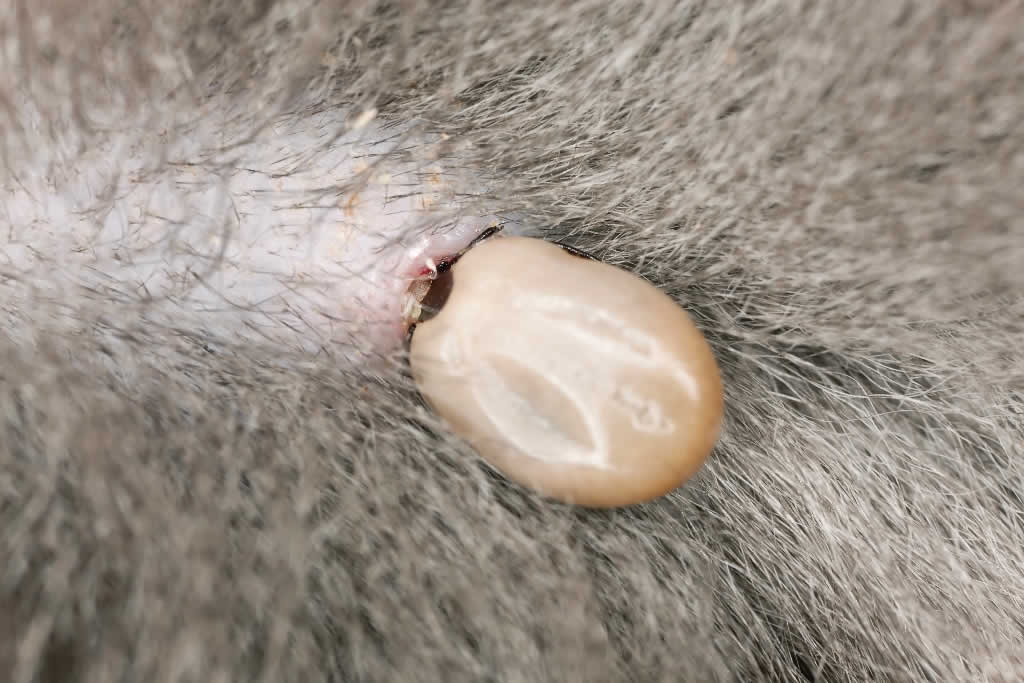Ticks are a problem for cats, dogs, and humans. They can potentially transmit Lyme’s disease, and often cause a nasty localised reaction in our pets.
There are products available for cats and dogs which prevent ticks from having the ability to survive long enough to find a place suitable to burrow their heads under the skin, which is also when the transmission of Tick borne disease occurs.
Typical symptoms of Lyme disease in dogs include:
 * Fever.
* Fever.
* Loss of appetite.
* Reduced energy.
* Lameness (can be shifting, intermittent, and recurring)
* Generalized stiffness, discomfort, or pain.
* Swelling of joints.
Although dogs and cats can get Lyme disease, there is no evidence that they spread the disease directly to their owners. However, pets can bring infected ticks into your home or yard. Consider protecting your pet, and possibly yourself, through the use of tick control products for animals.
Please call in or contact us to discuss preventative treatments for your pets.
Ticks also transmit Lyme’s disease to humans
Many people with early-stage Lyme disease develop a distinctive circular rash at the site of the tick bite, usually around three to 30 days after being bitten.
The rash is often described as looking like a bull’s-eye on a dart board. The affected area of skin will be red and the edges may feel slightly raised.
The size of the rash can vary significantly and it may expand over several days or weeks. Typically it’s around 15cm (6 inches) across, but it can be much larger or smaller than this. Some people may develop several rashes in different parts of their body.
However, around one in three people with Lyme disease won’t develop this rash.
Some people with Lyme disease also experience flu-like symptoms in the early stages, such as tiredness (fatigue), muscle pain, joint pain, headaches, a high temperature (fever), chills and neck stiffness.
Later symptoms
More serious symptoms may develop several weeks, months or even years later if Lyme disease is left untreated or is not treated early on. These can include:
* pain and swelling in the joints (inflammatory arthritis)
* problems affecting the nervous system – such as numbness and pain in your limbs, paralysis of your facial muscles, memory problems and difficulty concentrating.
When to see your GP
You should see your GP if you develop any of the symptoms described above after being bitten by a tick, or if you think you may have been bitten. Make sure you let your GP know if you’ve spent time in woodland or heath areas where ticks are known to live.
Diagnosing Lyme disease is often difficult as many of the symptoms are similar to other conditions. A spreading rash some days after a known tick bite should be treated.
How you get Lyme disease
If a tick bites an animal carrying the bacteria that cause Lyme disease (Borrelia burgdorferi), the tick can also become infected. The tick can then transfer the bacteria to a human by biting them.
Ticks can be found in any areas with deep or overgrown vegetation where they have access to animals to feed on.
They’re common in woodland and heath areas, but can also be found in gardens or parks.
Ticks don’t jump or fly, but climb on to your clothes or skin if you brush against something they’re on. They then bite into the skin and start to feed on your blood.
Generally, you’re more likely to become infected if the tick remains attached to your skin for more than 24 hours. But ticks are very small and their bites are not painful, so you may not realise you have one attached to your skin.
Who’s at risk and where are ticks found?
People who spend time in woodland or heath areas in the UK and parts of Europe or North America are most at risk of developing Lyme disease.
Most tick bites happen in late spring, early summer and autumn because these are the times of year when most people take part in outdoor activities, such as hiking and camping.
It’s thought only a small proportion of ticks carry the bacteria that cause Lyme disease, so being bitten doesn’t mean you’ll definitely be infected.
However, it’s important to be aware of the risk and seek medical advice if you start to feel unwell.
Spring Greetings!
Spring greetings from us all at Prospect House Vets
Easter Opening Times at Prospect House
The Practice will be closed over the whole Easter Weekend
Autumn Newsletter
Read our autumn newsletter from Prospect House Vets









